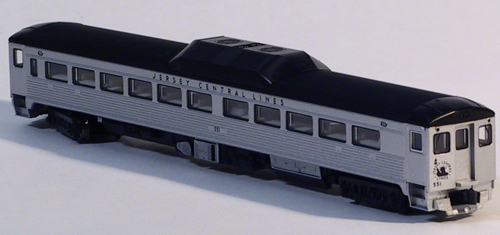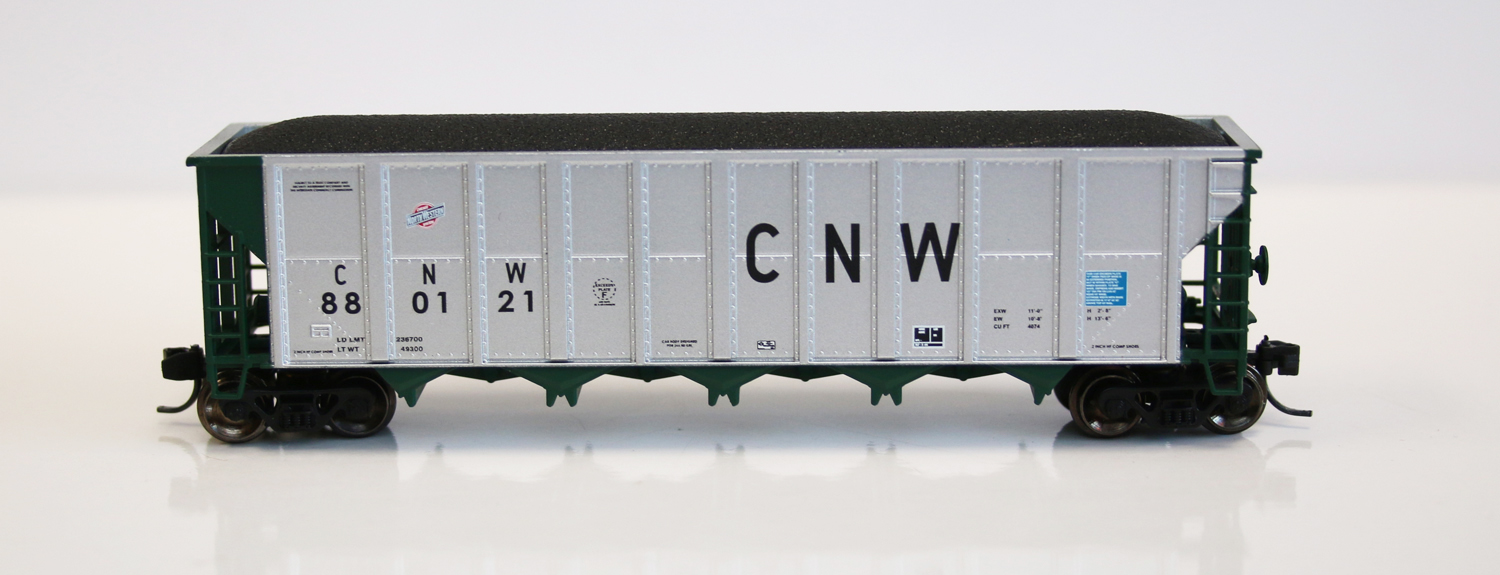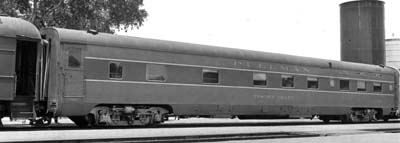Prototype History: As lightweight articulated streamliners were proving their reliability and economy on the Union Pacific and Burlington route, Santa Fe made its' first investment in modern equipment with an order to Budd for a stainless steel coach numbered 3070 delivered in January of 1936. The car would be built with the patented Shotweld process that produced a full size car with a great savings in weight over the standard riveted cars (83,000 vs. 160,000 lbs.) The shiny fluted sides gave a pleasant appearance to the car and were easy to maintain. Santa Fe's second lightweight car, 3071, built at St. Louis Car Co. from welded Corten steel came in at 98,00 lbs., a great weight savings but not enough to sway Santa Fe from placing orders for 103 cars with Budd for eight new streamline train sets: a new Super Chief, San Diegan, Tulsan and twin sets for El Capitan, Golden Gate and Chicagoan-KansasCitian. A second Super Chief was also added. 47 more cars were ordered for delivery 1940-1942
119 6 Sec-6 Rmt-4 DB cars were built under Lot #6669 to Plan 4099 and delivered in June of 1942. Except for exterior paint and air conditioning systems the cars were identical and assigned to the Missouri Pacific (4), Erie (4), Illinois Central (12), Overland Route (60), Golden State (13) Santa Fe (26). These were the first smooth side streamline sleepers on the Santa Fe. These cars were to be used to provide new sleeping cars for secondary trains Grand Canyon and Ranger. Painted in the new Pullman two-tone gray scheme these cars were pressed into service during the war on the previously all-stainless steel sided Chief.
119 6 Sec-6 Rmt-4 DB cars were built under Lot #6669 to Plan 4099 and delivered in June of 1942. Except for exterior paint and air conditioning systems the cars were identical and assigned to the Missouri Pacific (4), Erie (4), Illinois Central (12), Overland Route (60), Golden State (13) Santa Fe (26). These were the first smooth side streamline sleepers on the Santa Fe. These cars were to be used to provide new sleeping cars for secondary trains Grand Canyon and Ranger. Painted in the new Pullman two-tone gray scheme these cars were pressed into service during the war on the previously all-stainless steel sided Chief.
Road Name History: Via Rail Canada (reporting mark VIA) (generally shortened to Via Rail or Via; styled corporately as VIA Rail Canada) is an independent crown corporation, subsidized by the Minister of Transport, mandated to offer intercity passenger rail services in Canada.
On January 12, 1977, CN spun off its passenger services as a separate Crown corporation, VIA Rail Canada. At its inception, Via acquired all CN passenger cars and locomotives. Following several months of negotiation, on October 29, 1978, Via took over operation of CP passenger train services, and took possession of cars and locomotives. Passenger train services which were not included in the creation of Via Rail included those offered by BC Rail, Algoma Central Railway, Ontario Northland Railway, Quebec North Shore and Labrador Railway, various urban commuter train services operated by CN and CP, and remaining CN passenger services in Newfoundland.
On January 12, 1977, CN spun off its passenger services as a separate Crown corporation, VIA Rail Canada. At its inception, Via acquired all CN passenger cars and locomotives. Following several months of negotiation, on October 29, 1978, Via took over operation of CP passenger train services, and took possession of cars and locomotives. Passenger train services which were not included in the creation of Via Rail included those offered by BC Rail, Algoma Central Railway, Ontario Northland Railway, Quebec North Shore and Labrador Railway, various urban commuter train services operated by CN and CP, and remaining CN passenger services in Newfoundland.
Brand/Importer Information: KATO U.S.A. was established in 1986, with the first U.S. locomotive model (the GP38-2, in N-Scale) released in 1987. Since that time, KATO has come to be known as one of the leading manufacturers of precision railroad products for the modeling community. KATO's parent company, Sekisui Kinzoku Co., Ltd., is headquartered in Tokyo, Japan.
In addition to producing ready-to-run HO and N scale models that are universally hailed for their high level of detail, craftsmanship and operation, KATO also manufactures UNITRACK. UNITRACK is the finest rail & roadbed modular track system available to modelers today. With the track and roadbed integrated into a single piece, UNITRACK features a nickel-silver rail and a realistic-looking roadbed. Patented UNIJOINERS allow sections to be snapped together quickly and securely, time after time if necessary.
The Kato U.S.A. office and warehouse facility is located in Schaumburg, Illinois, approximately 30 miles northwest of Chicago. All research & development of new North American products is performed here, in addition to the sales and distribution of merchandise to a vast network of wholesale representatives and retail dealers. Models requiring service sent in by hobbyists are usually attended to at this location as well. The manufacturing of all KATO products is performed in Japan.
Supporters of KATO should note that there is currently no showroom or operating exhibit of models at the Schaumburg facility. Furthermore, model parts are the only merchandise sold directly to consumers. (Please view the Parts Catalog of this website for more specific information.)
In addition to producing ready-to-run HO and N scale models that are universally hailed for their high level of detail, craftsmanship and operation, KATO also manufactures UNITRACK. UNITRACK is the finest rail & roadbed modular track system available to modelers today. With the track and roadbed integrated into a single piece, UNITRACK features a nickel-silver rail and a realistic-looking roadbed. Patented UNIJOINERS allow sections to be snapped together quickly and securely, time after time if necessary.
The Kato U.S.A. office and warehouse facility is located in Schaumburg, Illinois, approximately 30 miles northwest of Chicago. All research & development of new North American products is performed here, in addition to the sales and distribution of merchandise to a vast network of wholesale representatives and retail dealers. Models requiring service sent in by hobbyists are usually attended to at this location as well. The manufacturing of all KATO products is performed in Japan.
Supporters of KATO should note that there is currently no showroom or operating exhibit of models at the Schaumburg facility. Furthermore, model parts are the only merchandise sold directly to consumers. (Please view the Parts Catalog of this website for more specific information.)
Item created by: gdm on 2016-04-18 16:02:42. Last edited by CNW400 on 2020-09-17 19:36:09
If you see errors or missing data in this entry, please feel free to log in and edit it. Anyone with a Gmail account can log in instantly.
If you see errors or missing data in this entry, please feel free to log in and edit it. Anyone with a Gmail account can log in instantly.











